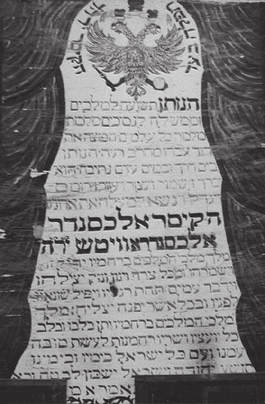Origins of the double-headed eagle The two-headed eagle is of Hittite origin. The Hittites were an ancient Anatolian (modern-day Turkey) people who formed an empire between 1600-1180 BC and the Hittite Empire reached great heights during the mid-1300s BC, when it spread across Asia Minor, into the northern Levant and Upper Mesopotamia (CC BY-SA 4.0) Following the Hittites two-headed eagles, there is a gap of almost two millennia before the double-headed eagle motif reappears. Jewish Heraldry and Chandeliers in synagogues The symbol is not considered to be a jewish symbol in itself, however the double-headed eagle was a common heraldic item that was used on chandeliers in Ashkenazi synagogues and on objects such as menorah's, torah shields, as well as as on jewish tombs and in the home, throughout Europe until the Second World War. Like others, European Jews used heraldry and adopted coats of arms, and contrary to the belief that heraldry was reserved for nobility or knights, it appears that the Jewish use can be traced back as far as to the 14th century. The two-headed eagle consists of the body, wings and claws of an eagle and has two heads, however in my Hamsa hand artworks I have used just the two heads connected to the body. Since ancient times, objects and lights have been adorned with symbolic imagery and many symbols are associated with light. In pagan art for example, the figure of the Roman god Jupiter (in Greek mythology the equivalent is Zeus) can be seen under a canopy-shaped handle of a bronze oil lamp, and the thunderbolts recall the divine origin of fire. Chandeliers from the 17th and 18th century found in the synagogue in Worms and in Prague, showed Jupiter on an eagle with thunderbolts, reflecting the association with celestial light (Rodov, 2004). Some scholars have suggested the use of the double-headed eagle among European Jews were a sign of loyalty to the government, however others suggest that its symbolism must be found in the interplay of its connection to light as well as its religious and political connotations in the specific countries and times (Rodov, 2004). Jewish heraldic shields had biblical motifs of menorah's and the star of David. Jews also used animals in the heraldic emblems of which the lion was notable, among the Christians too, as well as the eagle. Unique heraldic seals were also used by some Jewish communities such as the Jews in Paris who during the 13th century used the eagle rising on a fleurs-de-lys. In Jewish art, the double-headed eagles have usually been found in the accompanying inscriptions in ceiling paintings of wooden synagogues. The double-headed eagle however has been absent in the Jewish written sources where the single-headed eagle is more prominent. For more information about the double-headed eagle, the articles listed in the references are recommended. You can read more about the symbolism of the eagle itself that i use in my HAMSA ARTWORK in my blog post about the meaning of the eagle. Reference: Ilia Rodov, “The Eagle, Its Twin Heads and Many Faces: Synagogue Chandeliers Surmounted by Double-headed Eagles,” Jewish Ceremonial Objects in Transcultural Context (Studia Rosenthaliana, 37, 2004), pp. 77-129. http://www.hubert-herald.nl/TwoHeadedEagle.htm#Twoheadedeagleegypt
0 Comments
|
MAY-BELL
|







 RSS Feed
RSS Feed
